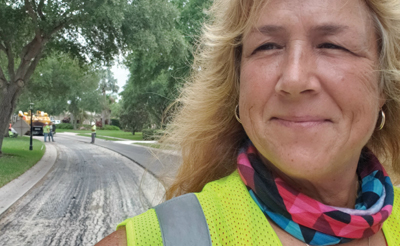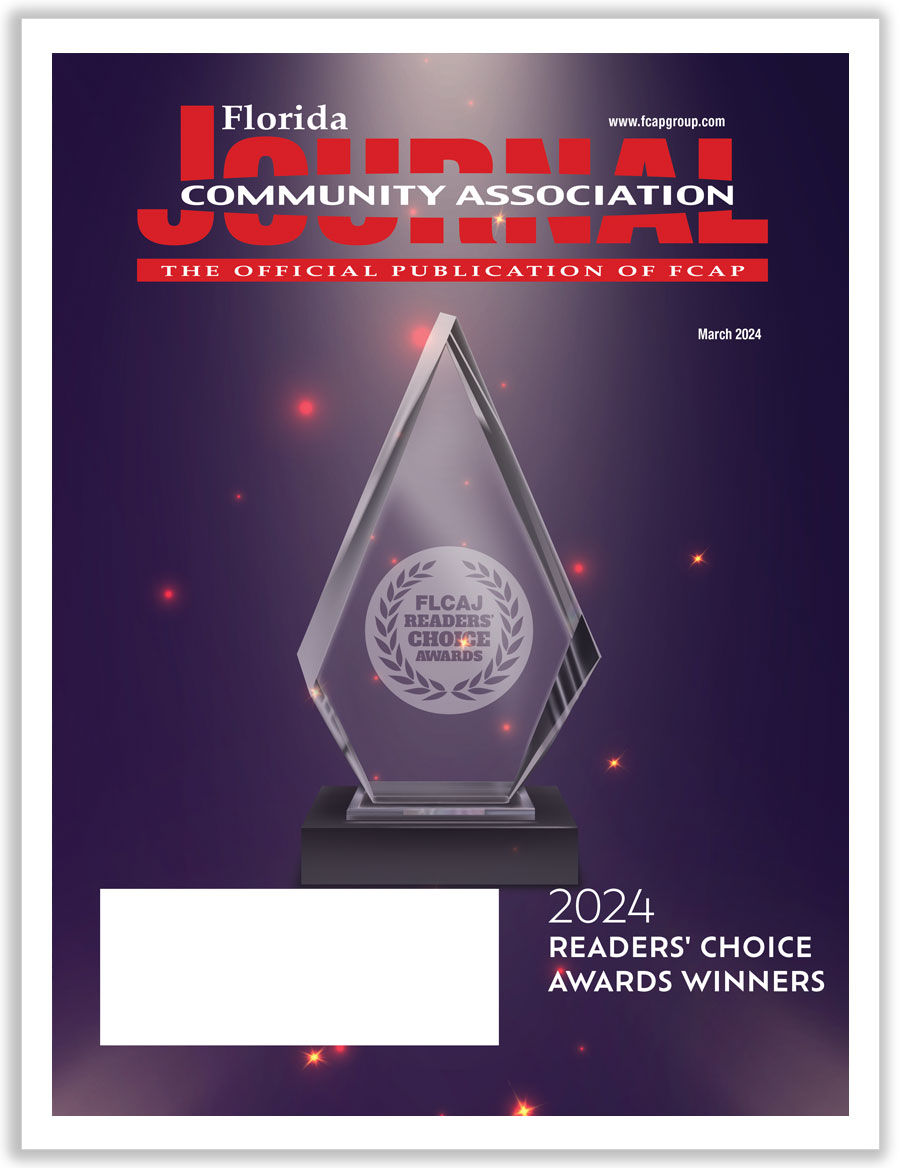
Right Product, Right Place, Right Time
By Connie Lorenz / Published February 2022

One of the biggest decisions a community board has to make is what to do with their asphalt. In most communities, their roadways and parking lots are the largest expense on the property unless they are responsible for the roofs. An asphalt maintenance program can either become an ongoing expense or a continual investment depending on what type of asphalt maintenance program a community chooses.
Below are some of the options you can choose from, but remember that what might be good for your neighboring community might not be the best product or process for yours! Money always factors into any decision; how-ever, it should not be the sole factor in choosing a maintenance program. For example, what if someone told you during the sales pitch that the process you are choosing, although the least expensive, was going to significantly reduce the life expectancy of your asphalt cap and you would have to apply it more frequently? Would you still choose it? Alternatively, what if someone showed you that applying a different product could triple the life of your pavement at one-tenth the cost of an overlay and could be applied every five to seven years, would you instead choose that process (or even believe them)?
These are the things that boards must factor in when moving forward with the asphalt maintenance for their community. Always remember when working with your asphalt, work from the top down and address anything above ground or from the bottom up and deal with any underground issues BEFORE addressing your pavement. Working in any other order will have you throwing good money after bad!
Sealcoating
Sealcoating or a water-based asphalt/coal tar emulsion can be applied to any age of pavement, usually after the first year, and is typically applied every two to three years though the manufacturers might recommend it every five years or sooner. Typical mix designs are 30–35 percent water with two to three pounds of sand per gallon. These products can be mixed by the contractor, or you can order certified mixes from the manufacturer, who will ensure that the sealcoating is being applied at the proper mixture rate.
 Sealcoating, a sacrificial surface, is best used on properties that want to have a wonderful aesthetic appeal at ALL times, such as clubhouses or entryways. Unfortunately, there are consequences to this type of surface treatment, depending on where you live in the country. Up north, where there is a freeze/thaw cycle and snowplows that accelerate the deterioration of the surface treatment, this type of product can be applied more frequently.
Sealcoating, a sacrificial surface, is best used on properties that want to have a wonderful aesthetic appeal at ALL times, such as clubhouses or entryways. Unfortunately, there are consequences to this type of surface treatment, depending on where you live in the country. Up north, where there is a freeze/thaw cycle and snowplows that accelerate the deterioration of the surface treatment, this type of product can be applied more frequently.
Here in Florida where there is a warmer climate and no snowplows, sealcoating tends to last longer than when applied in northern states. Therefore, the idea of applying a treatment every other year like you would up north has very opposite effects. Asphalt and sealcoating expand and contract at different temperatures, and when the asphalt adjusts to our constantly changing weather patterns, the sealer begins to crack to allow for this constant adjustment.
Through repeated applications, these cracks become larger and larger until a new milling and overlay is installed. Are you thinking about saving a couple of dollars and NOT milling out the defective, chicken wire cracked pavement? Think again! That $2.50 per square yard savings will cause you to replace your pavement sooner! Why? Because installing new asphalt on top of defective asphalt is like trying to install tile on top of shag carpeting! It will look really great until somebody drives on it! The picture shown above was taken within the first five years of a new overlay that was installed on top of old, cracked, sealcoated pavement! The board had to have a special assessment because they had to replace their pavement 10 years before budgeted!
Asphalt Rejuvenators
Asphalt rejuvenators are one of my favorite products on the market, provided you are working with the right ones! There are clear rejuvenators which are maltene based and are designed to replace the maltenes that have been lost due to oxidation. There are vegetable oil derivatives, like soybean oil, which is eco-friendly, and like the other clear rejuvenators, dries in a few hours. An advantage is that you don’t have to replace your pavement markings! There are black rejuvenators that not only beautify your property but also provide protection from fluid spill damage and recondition the binders that have been lost due to oxidation. Although there are versions of the originals, most don’t have a lot of testing or present testing from the original product (not theirs). Remember, after patents expire, manufacturers don’t have any say so on who comes up with the newest version of their inventions nor on how they promote them.
 Some products claim to be rejuvenators or use terms like “rejuvenate your asphalt.” However, while implying that their products will “rejuvenate,” what they in fact mean is that they will rejuvenate the appearance of the asphalt, not the integrity of the cap itself by rejuvenating the binders.
Some products claim to be rejuvenators or use terms like “rejuvenate your asphalt.” However, while implying that their products will “rejuvenate,” what they in fact mean is that they will rejuvenate the appearance of the asphalt, not the integrity of the cap itself by rejuvenating the binders.
For a period, some rejuvenators even contained components which are not allowed in the USA. Unfortunately, due to some very unclear or even fraudulent specifications, these products slipped through the cracks and were allowed to be utilized, at least until everyone figured it out.
The definition of an asphalt rejuvenator is, “A material that will significantly lower viscosity, increase penetration, lower softening point, and increase the ductility of the binder without disturbing the binder’s ability to retain aggregate, and not significantly lower skid resistance.” (Brown, McGovern, Rostler and White). Clearly, asphalt rejuvenators have very real performance expectations, so make sure when you are investigating these types of surface treatments that they are truly an asphalt rejuvenator and not an over glorified surface treatment. Every rejuvenator is a softener, but not all softeners are rejuvenators!
Micro Paving
Micro paving is a thin asphalt overlay that can be applied to an existing asphalt cap if it’s in good condition and stable. SuperPave 4.5 is a wonderful example of this type of surface application and gives a community a refreshed new appearance with the structural stability of asphalt. This product can be applied about ¼-in. thick and does an excellent job covering up scuffs and things that sealcoating and rejuvenators cannot, without actually correcting the defect.
Some communities are installing this type of asphalt lift on top of asphalt that was clearly defective prior to its application. Because of this, the community began seeing the new lift fail within months as the reflective cracking or “mirroring” from the original issue rises into the new surface. If you want to utilize this type of product, please make sure that any defects are corrected BEFORE installing the new lift!
Micro-Surfacing
Micro-surfacing can be either a heavy aggregate sealcoating or a proprietary mixture and is one of my FAVORITE products as well! Heavy aggregate treatments like this can be made up of an assortment of components such as polymers and recycled products, or in some cases, the contractor adds 8 to 10 pounds of sand per gallon to their sealcoating mixture, charges a higher price, and the check is cashed long before the community knows what hit them!
These products are amazing if they are the right ones and can be applied on top of the sealcoat cracking that we are all so familiar with. Please be aware that though it can be applied on top of this type of defective pavement, the cracking will reflect up into the new asphalt cap in no time, but the pavement will stay black for what seems like FOREVER!
Asphalt Overlay
An asphalt overlay is when a contractor comes in and installs a new asphalt cap on top of the existing asphalt cap on property. They will apply a tack coat and then install the new asphalt directly on top of the old one. This is wonderful as it adds additional structural stability to your roadways as well as adds life to the existing asphalt cap. Don’t be fooled, though; with the increase in the percentage of allowable RAP (reclaimed asphalt products), we pay a higher price for asphalt for a lesser quality pavement!
Please be aware that attempting to install a new asphalt cap on top of defects will result in the defects rising into the new asphalt surface once traffic drives on it! All defects must be stabilized and corrected before installing the new lift. Typically, a community will install a 1-in. overlay, but make sure you are not confused on the difference between installing a 1-in. asphalt lift versus having a 1-in. final lift installed. The difference is about ¼-in. on the final product, or with a Type S-III Hot Mix or SuperPave 9.5 Mix, that’s about a #57 stone deep or about the size of a pencil eraser.
 Also keep in mind that if you have a soil cement sub-base, the symmetrical checkerboard cracking will always reflect up and is a natural part of your sub-base. These sub-bases are known as “floating bases” and are designed to rise and settle as the water table adjusts! You can install a crackfill prior to installing a new overlay to slow down their appearance, but eventually these cracks will rise through.
Also keep in mind that if you have a soil cement sub-base, the symmetrical checkerboard cracking will always reflect up and is a natural part of your sub-base. These sub-bases are known as “floating bases” and are designed to rise and settle as the water table adjusts! You can install a crackfill prior to installing a new overlay to slow down their appearance, but eventually these cracks will rise through.
Another item to take into consideration when looking at installing a new overlay without milling is how the new asphalt cap will lay next to your hardscapes. Items such as your drain basins, manholes, sidewalks, and driveways are typically flush with the pavement, and installing a 1-in. overlay may require you to install riser rings on your hardscapes or transition mill in these areas to allow for proper water run off as well as to keep the areas safe for any pedestrians in the area.
Milling and An Overlay
Milling is when a contractor brings in a machine that seems to be the size of a building and grinds up the existing asphalt cap on your property. The milling is a very slow process and is also very dirty, but with a good operator and great contractor, the milling machine can fix a lot of preexisting issues with the right instruction! Milling machines can take out tree roots and concrete beneath the asphalt cap and remove mounded areas and level out depressed ones. They can take out damaged sub-base areas and allow the contractor to black base the weakest areas or stabilize it prior to paving.
Once the asphalt is milled up, they then haul away all the debris to the asphalt plant where it is recycled and becomes someone else’s pavement (this is known as RAP, which I mentioned earlier). After all, asphalt is 100 percent recyclable! The contractor will then finish cleaning up the loose debris and prep the roadway for paving. Don’t worry about the “scabs” or the rough areas of asphalt lying around, as those will be fine and will not be visible after the new pavement is installed.
The paving contractor will then apply the tack or “glue” to the areas to be paved. This product goes down like a terracotta color and then cracks or cures black when it’s ready to be paved on top of. Once the tack is ready, the contractor will begin bringing in the asphalt trucks and start placing your new roadways. I know everyone sees them driving on it, but wait until they open them up for traffic. Good contractors work with temperatures and know how to drive on new asphalt without breaking the bond, and if only one half of the roadway is down and someone passes over the edge, there is a good chance you will have a puddle forever where they crossed over!
Now that we know what our options are, the next question is always, what is the price? I would like to say that sealcoating was this and rejuvenation was this, but I can’t! Why? There are so many factors that go into pricing, like quality of workers, location, material selection, mix design, etc. What I can do is give you an average of what I have seen in the market for the central Florida area. I can tell you that these prices are higher in southern and northern Florida and can be affected by what I refer to as the “bridge tax” if you are one of those communities located on or near our beautiful beaches and waterways!
Based on a 20,000 square yard property, let’s say open roadways, sealcoating could go for about $1.25 per sq. yd.; rejuvenation between $1.35 and $2.00 per sq. yd.; micro-surfacing about $3.00 to $5.00 per sq. yd. depending on product and process; micro-paving about $5.00 per sq. yd.; a 1-inch overlay on top of existing asphalt about $7.00 to $8.00 per sq. yd.; and a full milling and 1 ½–in. overlay, about $13.00 per sq. yd. on average. As you can see, the prices vary greatly, so it’s easy to see why boards might make decisions based on pricing rather than what is best for their community!
 Other aspects to consider would be, “Is the area in question a high visibility, event holding area” that you want to keep always refreshed? Sealcoat, but make sure that you include the increased cost of ownership from more maintenance as well as having to replace it sooner than other areas. Untreated, virgin asphalt, hands down rejuvenation! Use a product that will decrease the maintenance cost as well as extend the life of the asphalt cap. Under three years of age, go with the clear treatment for one application, two if you can! After that, go with a rejuvenator that can not only protect your binders but provide aesthetic appeal and preserve your pavement at the age its applied!
Other aspects to consider would be, “Is the area in question a high visibility, event holding area” that you want to keep always refreshed? Sealcoat, but make sure that you include the increased cost of ownership from more maintenance as well as having to replace it sooner than other areas. Untreated, virgin asphalt, hands down rejuvenation! Use a product that will decrease the maintenance cost as well as extend the life of the asphalt cap. Under three years of age, go with the clear treatment for one application, two if you can! After that, go with a rejuvenator that can not only protect your binders but provide aesthetic appeal and preserve your pavement at the age its applied!
Do you have untreated, aged pavement with some stress cracks, but overall your asphalt cap is in good shape, and your budget isn’t? Micro-paving for sure! Is your clubhouse old sealcoating with the drive lanes bare and the parking stalls black and cracked, and you want to put down “something” to refresh the appearance, fill in the cracks, and buy you some time? Micro-surfacing! Your pavement is thin but in good shape, and you have a small lip along your hardscapes, then install a 1-in. lift! The aggregate is barely keeping it together and is basically rocks holding hands with severe cracking, alligatoring, and potholes? Mill and pave!
No matter what, it is a board’s fiduciary responsibility to take care of their community to the best of their ability with the funds they have available. Setting up an asphalt maintenance program for the community and not just the sitting board will put a community on track and allow them to budget properly over the coming years without surprises!
If a community only does crisis management, then they will pay crisis management pricing! It is a shame to see communities throw money away by only addressing issues when they have no other choice. It seems like it is such an easy decision to perform preventive maintenance and regular maintenance, often avoiding these crisis issues. Even more wonderful is that this type of program also extends the life of your existing cap, up to three times the normal life expectancy with the right product, at the right place, and at the right time.
Connie Lorenz
Owner, Asphalt Restoration Technology Systems Inc. (AR Tech)
Asphalt Restoration Technology Systems Inc. (AR Tech) is led by Connie Lorenz, also known as the “Asphaltchick,” and provides education and consultation services on proper asphalt maintenance. As a multi-year recipient of the Florida Reader’s Choice Award and Pulse of the City Awards, and one the of Top 50 Asphalt Contractors in the country four years and running through Pavement Maintenance and Reconstruction Magazine, we are the team to turn to! We provide a no-cost, detailed evaluation, property specific, with our proposals and offer board presentations to explain the different options available for pavement maintenance today. For more information on Asphalt Restoration Technology Systems, call (800) 254-4732 or visit www.asphaltnews.com.




